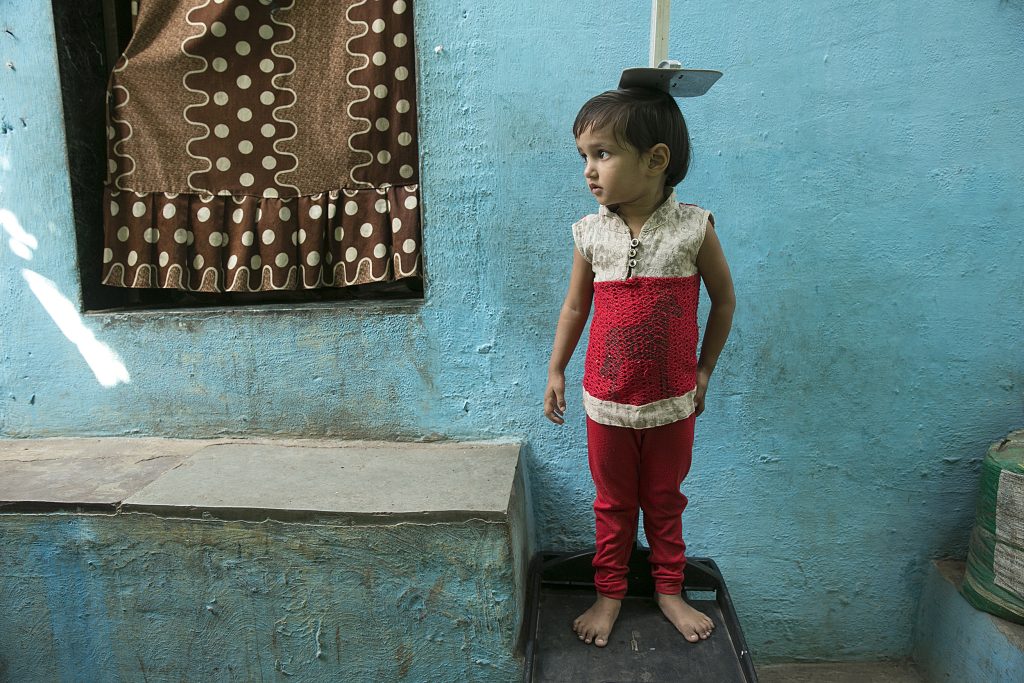
© 2016 Mayank Soni (Save the Children), Courtesy of Photoshare
An interview with Jef Leroy, IFPRI
Stunting, or children assessed as too short for their age, has become a north star indicator for the nutrition community. Many advocates, policy makers, implementers, and funders use stunting to assess impact of nutrition investments. The high prevalence of stunting and the population-level association seen between stunting, child development and longer-term outcomes drive this focus. But is stunting the best metric to capture progress in nutrition?
In March 2019 Dr. Jef Leroy a Senior Research Fellow in the International Food Policy Research Institute’s (IFPRI) Poverty, Health, and Nutrition Division and Dr. Edward Frongillo Director of Global Health Initiatives at the University of South Carolina Arnold School of Public Health, published a review in Advances in Nutrition that critically assessed how stunting is used as a the priority outcome in policy, program evaluations, funding, and research. They examine the underlying causal assumption that interventions which impact linear growth, and subsequently stunting, improve a host of outcomes related to child development, productivity and earnings in adulthood, and chronic diseases.
The authors conclude that stunting is useful as a marker of a problem but that to appropriately capture nutrition impact, we need to move beyond our current narrow focus on stunting. The pair also published an opinion piece in Devex and released a brief video that further explain the implications of their findings.
In our work, DataDENT focuses on filling gaps in nutrition metrics that help decision makers make better policy decisions. We sat down with Jef Leroy (JL) to discuss the implications of their findings for the nutrition data value chain.
*The interview has been edited for clarity and length.
Q: As you mention in the review, reducing child stunting has become a global focus for the nutrition community. With that in mind, what have been the reactions to your article? Who still needs to be convinced and what efforts have you been engaging in to help move the conversation forward?
JL: I’ve presented this work to scientific audiences, to funders, and to program people. If anything, I sense some sort of relief. The paper establishes that stunting is not the ultimate nutrition outcome. There are other outcomes that are relevant and that we should use to assess whether a policy or a program has been successful.
Where questions come up is in how the global community and policy makers are going to respond. Are we now saying that stunting is not a good metric? No. We highlight that it all depends on what you want to measure. Stunting is a great measure for tracking global and country progress and for comparing the severity of undernutrition across countries or regions within a country. The existence of stunting shows that things are not going well for children and that many children in these affected areas will not reach their full potential.
However, there is one caveat that is important. It is not just the stunted children that suffer. Stunting and linear growth retardation are measures of the severity of the problem. It’s not a count of those who are affected by the problem. There are hundreds of million more children whose height does not fall below the cut-off for stunting but who nevertheless suffer from undernutrition and will therefore never reach their full potential. That is the distinction that we need to bring to the level of the policy makers.
Where change is needed is in how we assess the impact of programs. We need to pay much closer attention to the outcomes that directly matter – dietary adequacy, nutrient status, early child development, enteropathy, etc. Most of these outcomes are harder to measure than linear growth but that doesn’t mean that we shouldn’t do it.
Q: How do you think about communicating nuance, especially policy makers and funders?
JL: We want to make sure that our work ultimately leads to improvements in the health and wellbeing of children. That’s really what counts. It’s not about having written a smart article that people are talking about. So, first, for the paper, we spent a lot of time making sure we weren’t being confrontational, but constructive. The objective is to improve how we collectively do things. It’s not us against the others. We tried to write the article with that in mind. Second, we wrote an opinion piece on Devex and produced a brief video we released shortly after. We spent time making sure the message was straightforward but accurate. The analogy we used in the opinion piece and the video is that of the smoke alarm. It is simple, but it clearly shows the importance of differentiating between detecting a problem and what you do to solve that problem. The image is a powerful one that we can use with policymakers too.

Q: What suggestions do you have for researchers to ensure that we are measuring the right things which can be used and interpreted by policy makers?
JL: We have to question what we measure, what the purposes is of what we measure, and if the measures we use are valid for these purposes. We need to do that constantly. Interestingly, with respect to linear growth retardation and stunting, I recently came across a paper from the 90s which explicitly state some of the key messages of our recent article, i.e. that stunting is more than anything else a marker of a deficient environment. In 20 years, we appear to have completely lost that nuance. Regularly stepping back and wondering whether what we do still makes sense is important.
Note: IFPRI is a member of the DataDENT consortium of partners which also includes Results for Development (R4D) and the Johns Hopkins School of Public Health (JHSPH).
